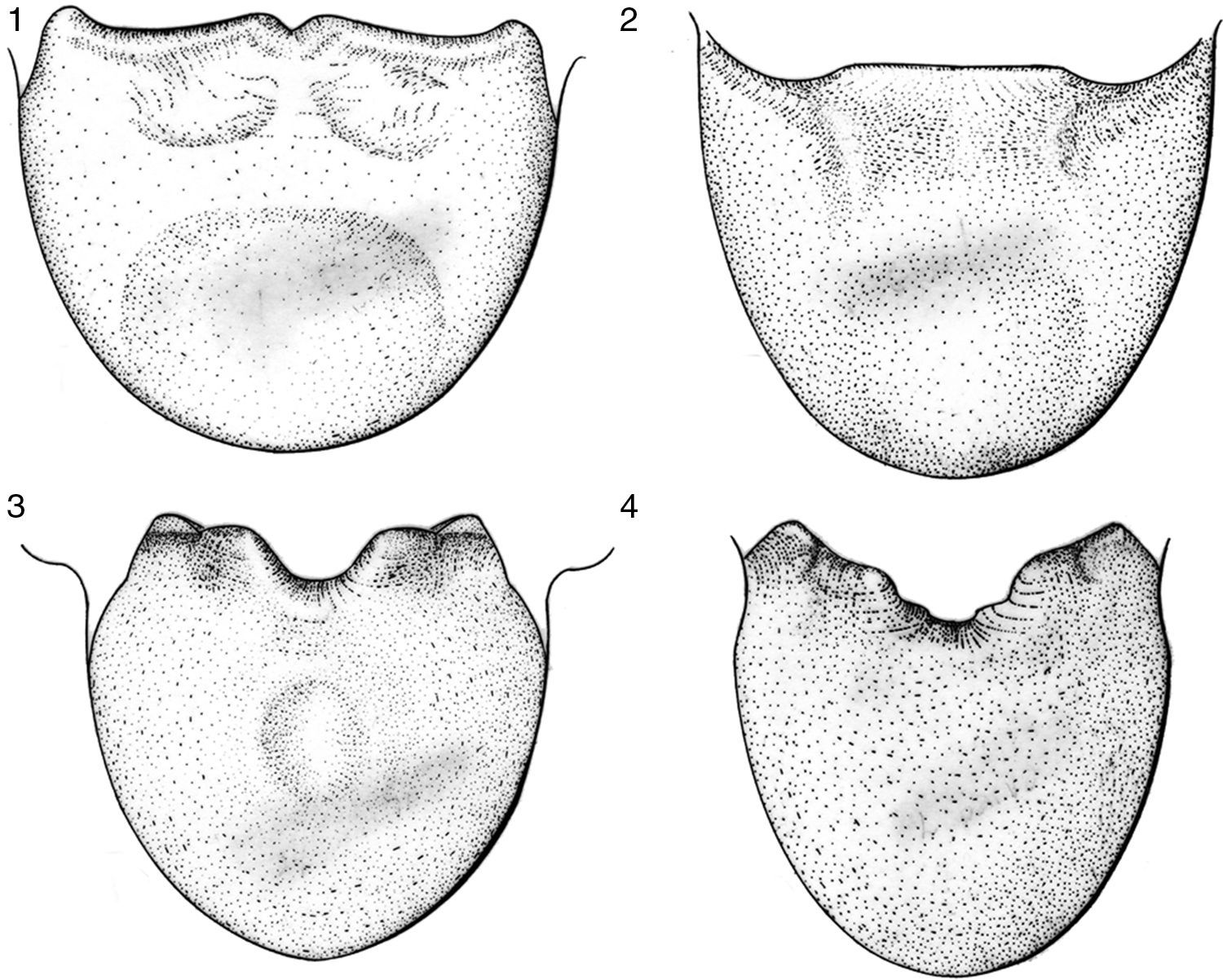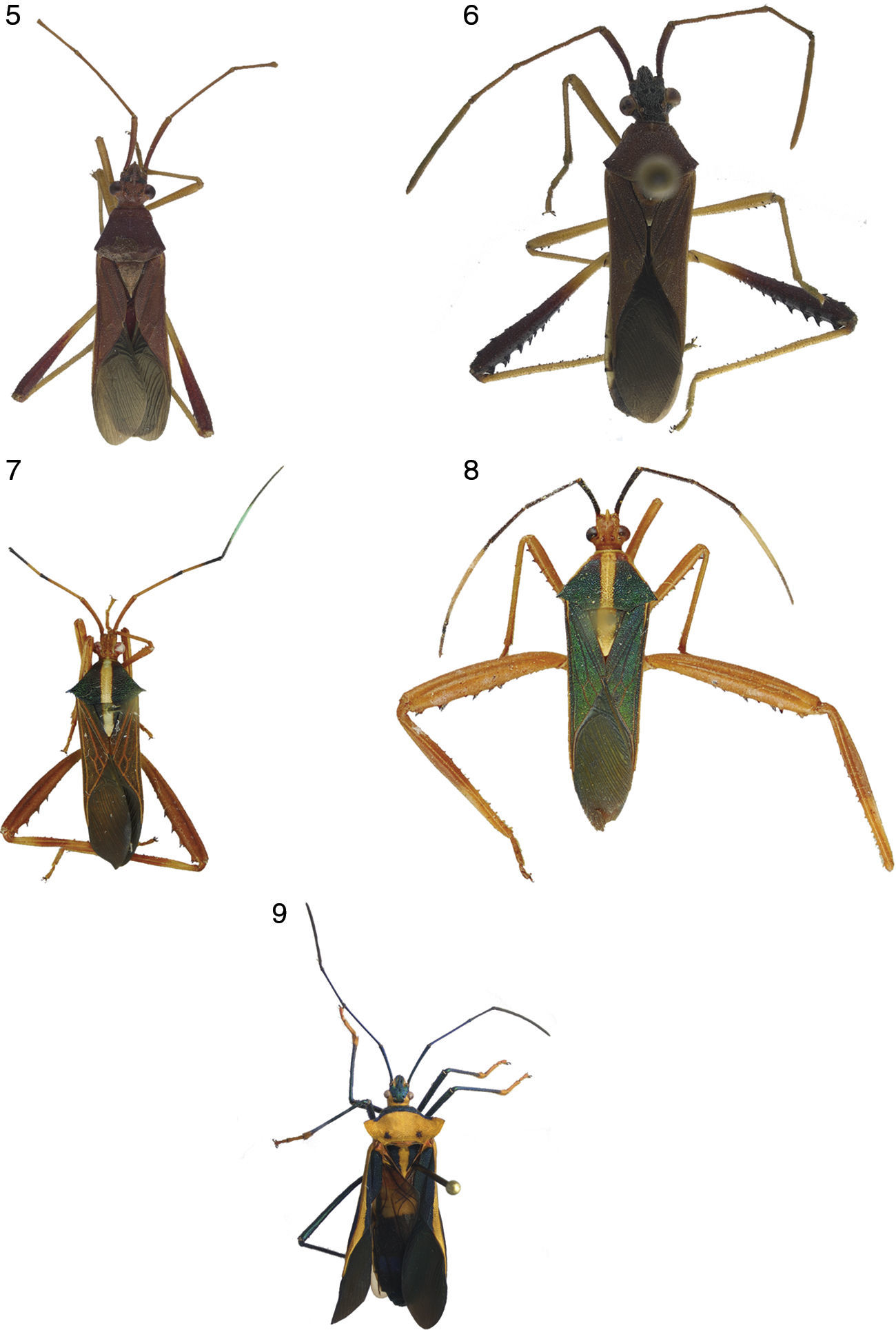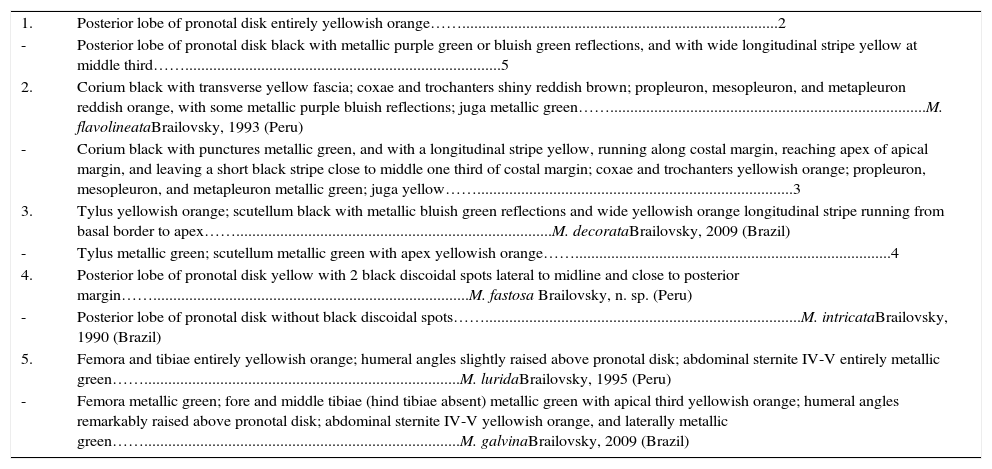Lucullia guilberti n. sp., from French Guiana is described in the tribe Acanthocephalini, Leptostellana infuscata n. sp., from Panama, and Malvanaioides fastosa n. sp., from Peru in the tribe Anisoscelini. Each species is compared with the related species. Photos in dorsal view, and drawings of male genital capsule are included. Keys to the known species in each genus are given.
Se describe Lucullia guilberti n. sp., de la Guyana Francesa incluyéndola en la tribu Acanthocephalini y Leptostellana infuscata n. sp., de Panamá y Malvanaioides fastosa n. sp., del Perú en la tribu Anisoscelini. Cada especie es comparada señalando las diferencias con su especie afín. Se incluyen fotografías en vista dorsal y dibujos de la cápsula genital del macho. Se proporcionan las claves para la separación de las especies conocidas de cada género.
The New World tribe Acanthocephalini is recognized by having the tylus conspicuously projecting beyond juga as a distinct knob or strongly compressed plate; and juga strongly deflexed (Packauskas, 1994). The genus LuculliaStål, 1865, previously includes 1 species Lucullia flavovittataStål, 1865, from Brazil, and here the second species from French Guiana is described.
The New World tribe Anisoscelini Amyot and Serville is large and diverse characterized by having the hind tibiae expanded on both sides; tylus not or only vaguely projecting beyond juga; head with developed neck; hind femur not strongly incrassate in males; and antenniferous tubercles not occupying most of the anterior head space (Packauskas, 1994). On this contribution the second species of the genus LeptostellanaBrailovsky, 1997, collected in Panama is described. Previously only Leptostellana parvaBrailovsky, 1997, described from Costa Rica was known. The genus MalvanaioidesBrailovsky, 1990, include 5 species: M. decorataBrailovsky, 2009, M. flavolineataBrailovsky, 1993, M. galvinaBrailovsky, 2009, M. intricataBrailovsky, 1990, and M. luridaBrailovsky, 1995, and here 1 new species from Peru is described (Packauskas, 2010).
Keys to all taxa included on each genus are given.
Materials and methodsThe following abbreviations are used for the institution cited here: MNHN – Museum National d’ Histoire Naturelle, Paris, France; UNAM – Instituto de Biología, Universidad Nacional Autónoma de México.
All measurements are given in millimeters.
DescriptionsLeptostellana infuscata n. sp. (Figs. 3, 6).
Holotype, male. Dorsal color: head black; space between ocelli-eye yellowish orange; antennal segments I–III yellowish orange, segment IV yellow; pronotum orange; anterolateral and posterolateral borders, and posterior border dark yellow; scutellum orange with apex yellowish white; clavus and corium dull reddish orange with costal border dark yellow; hemelytral membrane smoky; connexival segments III–VI pale yellow with posterior angle black; connexival segment VII black with anterior margin yellow; dorsal abdominal segments black with posterior border of segments II–VI yellow. Ventral color: head shiny yellow with 2 shiny castaneous orange longitudinal stripes lateral to midline; rostral segments yellow (apex of rostral segment IV black); thorax shiny castaneous orange with inner border of each acetabulae yellow; anterior lobe of metathoracic peritreme yellow with black discoidal spot at middle, and posterior lobe yellow; fore and middle leg yellow; hind leg with coxae, trochanters, tibiae and tarsi yellow, and femur castaneous orange with basal joint yellow and ventral and dorsal spines black to reddish brown; abdominal sterna dark reddish brown with pleural margins yellow; genital capsule dark reddish brown.
Structure. Head: wider than long, pentagonal, porrect, produced forward between bases of antennae; tylus blunt, slightly projecting beyond jugae; antenniferous tubercle unarmed; antennal segment I shorter than head, thicker than succeeding segments and slightly curving; segments II and III cylindrical, IV fusiform; antennal segment I the shorter, IV the longest, and II longer than III; rostrum almost reaching posterior margin of metasternum. Thorax: pronotum wider than long, trapeziform, gradually declivent; collar wide; anterolateral borders obliquely straight, smooth; humeral angles subacute, not exposed; posterolateral borders sinuate, entire; posterior border straight; triangular process absent; calli elevated, raised area between calli with 2 tiny tubercles. Legs: fore femur ventrally with 2 small subapical spines, and 1 on the external surface; middle femur ventrally with 2 small subapical spines and 3 on the external surface; hind femur incrassate, ventrally armed with 2 rows of long and stout spines, the external row with 8 and the internal row with 5 spines; dorsally armed with 4 rows of short and stout spines; tibiae cylindrical and sulcate; fore and middle tibiae unarmed; hind tibiae armed with 2 rows of short and acute spines running on inner surface from base to apex. Scutellum: longer than wide, triangular, flat; apex subacute. Hemelytra. Macropterous. Abdomen: posterior angle of each connexival segment entire, without spine. Genital capsule: posteroventral edge with median notch deep and rounded; lateral margins wide and bifurcate; dorsal prongs absent (Fig. 3).
Measurements (holotype male). Head length 1.90; width across eyes 2.20; interocular space 1.04; interocellar space 0.57; preocular distance 1.12; length of antennal segments: I, 0.53; II, 3.44; III, 1.76; IV, 4.04; pronotal length 2.16; width across humeral angles including the humeral spine 3.32. Scutellar length 1.60; width 1.32. Total body length 12.20.
Female. Unknown.
Taxonomic summmaryMaterial examined. Holotype: male, Panama, Canal Zone, Diablo HTS, 24. VI. 1976, coll. E. G. Riley. Deposited in the collection of the Instituto de Biología, Universidad Nacional Autónoma de México (UNAM).
Etymology. From the Latin infuscus (dusky, dark or blackish): refers to the dark coloration of abdominal sterna III–VII and male genital capsule.
Distribution. Known from Panama.
RemarksThe only included species, L. parvaBrailovsky, 1997 (Figs. 4 and 5), recorded from Costa Rica is distinguished by having the hind femora dorsally unarmed, the anterior lobe of metathoracic peritreme yellow, and abdominal sterna III–VII shiny orange. In L. infuscata n. sp., distributed in Panama, the dorsal surface of hind femora is armed with 4 rows of stout spines, the anterior lobe of metathoracic peritreme are black, and abdominal sterna III–VII dark reddish brown with pleural margin yellow. The male genital capsule of both species exhibit differences on the concavity of the posteroventral edge, wider and deep in L. infuscata (Fig. 3) and less in L. parva (Fig. 4).
Key to known Leptostellana species.
| 1. | Hind femora dorsally armed with 4 rows of stout spines; anterior lobe of metathoracic peritreme black; abdominal sterna III–VII dark reddish brown with pleural margin yellow……...............................................................................L. infuscata n. sp. (Panama) |
| - | Hind femora dorsally unarmed; anterior lobe of metathoracic peritreme yellow; abdominal sterna III–VII shiny orange with upper border of pleural margin yellow……...............................................................................L. parvaBrailovsky, 1997 (Costa Rica) |
Lucullia guilberti n. sp. (Figs. 2, 7).
DiagnosisHolotype, male. Dorsal color: head shiny pale castaneous orange; ocelli and eyes red; antennal segment I pale shiny castaneous orange, II and III pale shiny castaneous orange with apical third black, IV black with yellow ring near middle third; pronotum and scutellum reddish brown to brown, scattered with metallic green iridescence and with wide yellow longitudinal stripe extending across pronotal disk to apex of scutellum; anterolateral borders of pronotum dark orange; clavus and corium reddish brown, veins pale orange brown, without metallic green iridescence; costal border of corium yellow; hemelytral membrane bronze with metallic green iridescence; connexivum pale castaneous orange; dorsal abdominal segments black with complete medial pale yellow longitudinal stripe. Ventral color: pale yellowish castaneous orange (apex of rostral segment IV black); pro-, meso-, and metapleura with transversal stripe castaneous orange; each abdominal sterna yellow with anterior margin and transversal stripe close to posterior margin castaneous orange; legs with tubercles and spines reddish brown.
Structure. Body large-sized (above 16mm), almost glabrous. Head: quadrate, parallel-sided; eyes hemispheric, protuberant; antenniferous tubercles unarmed, straight, nearly appressed to tylus; tylus nearly acute, flattened, resembling a triangular plate from side, extending beyond antenniferous tubercles by nearly half; juga shorter than tylus; antennal segment IV the longest, III the shortest, and I longer than II; posttylar sulcus single; preocellar pit deep; ocellar tubercles raised; postocular tubercle slightly exposed, following the contour of eye; buccula semicircular, reaching middle third of eye; rostrum reaching posterior border of mesosternum; rostral segment I not extending past head. Thorax: pronotum wider than long across humeral angles; trapezoidal; collar present; pronotal disk punctate, heavily rugose, non-tuberculate; callar region slightly raised; anterolateral borders finely tuberculate; posterolateral borders spinose; posterior border smooth, almost straight; triangular process tiny, hard to see; humeral angles expanded, acute, with the spine directed backward; mesosternum non-sulcate; metathoracic scent gland peritreme with 2 separated auricles, anterior auricle lobate, posterior auricle simple, not expanded. Legs: metapleura with short supracoxal spine; fore and middle femora slightly incrassate, ventrally armed with 2 rows of spines; hind femur strongly incrassate with lateral tubercles and 2 rows of dorsal tubercles or spines; hind tibiae slightly expanded, not emarginated, outer expansion narrow, unarmed, inner face spinated, slightly expanded. Genitalia. Posteroventral edge of genital capsule simple, almost straight (Fig. 2).
Female. Color: similar to male holotype. Antennal segment IV pale yellow with basal third and posterior third black; connexival segments VIII–IX, dorsal abdominal segments VIII–IX and genital plates pale castaneous orange to pale yellowish castaneous orange. Structure. Legs: metapleura lacking a supracoxal spine; all femora with 2 rows of ventral spines with the spines stronger and wider on anterior row; hind femur moderately incrassate; hind tibiae with outer and inner expansion unarmed.
Measurements (single measurements). First male, then female. Head length 1.90, 2.05; width across eyes 2.25, 2.40; interocular space 0.90, 0.92; interocellar space 0.40, 0.42; preocular distance 1.00, 1.03; length of antennal segments: I, 3.80, 4.10; II, 3.55, 3.80; III, 2.70, 3.15; IV, 7.65, 7.70; pronotal length 3.25, 3.90; width across humeral angles including the humeral spine 5.40, 6.70. Scutellar length 2.25, 2.90; width 1.70, 2.25. Total body length 16.38, 18.42.
Taxonomic summaryMaterial examined. Holotype, male, French Guyana, Mont Mitaraka, MTK PGL, Piege Lumineaux Automatique, 25. III. 2015, coll. E. Guilbert. Deposited in the collection of the Museum National d’ Histoire Naturelle, Paris, France (MNHN). Paratype, 1 female, French Guyana, Mont Saint Marcel, Luminating Trap, 29. IX. 2014, coll. S. Brule. Deposited in the collection of the Instituto de Biología, Universidad Nacional Autónoma de México.
Etymology. Dedicated to Eric Guilbert, distinguished French entomologist.
Distribution. Known from French Guyana.
RemarksThe only included species, L. flavovittataStål (1865) (Figs. 1, 8), recorded from Brazil (Packauskas, 2010) is easily distinguished by the following combination of characters: antennal segments II and III black; posterior lobe of pronotal disk with extensive metallic green iridescence; humeral angles with the apical spine short, stout, and slightly directed backward; clavus and corium with metallic green iridescence; dorsal abdominal segments pale yellowish orange with posterior border black; and posteroventral edge of male genital capsule with short depression at midline (Fig. 1). L. guilberti n. sp., distributed in French Guyana, is recognized by having the antennal segments II and III pale shiny castaneous orange with apical third black; posterior lobe of pronotal disk scattered with metallic green iridescence; humeral angles expanded, acute, with elongate spine directed backward; clavus and corium reddish brown, lacking a green metallic iridescence; dorsal abdominal segments black with complete median yellowish longitudinal stripe; and posteroventral edge of male genital capsule simple, almost straight (Fig. 2).
Key to known Lucullia species.
| 1. | Antennal segments II–III black; posterior lobe of pronotal disk, clavus and corium with extensive metallic green iridescence; humeral angles with apical spine short, stout, directed backward; dorsal abdominal segments pale yellowish orange with posterior border black……...............................................................................L. flavovittata Stål (Brazil) |
| - | Antennal segments II–III pale shiny castaneous orange with apical third black; posterior lobe of pronotal disk scattered with metallic green iridescence; clavus and corium reddish brown, lacking a green metallic iridescence; humeral angles expanded, acute, with elongate spine directed backward; dorsal abdominal segments black with complete median yellowish longitudinal stripe……...............................................................................L. guilberti n. sp. (French Guyana) |
Malvanaioides fastosa n. sp. (Fig. 9).
DiagnosisHolotype, female. Dorsal color: head metallic green with following areas shiny yellow: external margin of juga, narrow stripe between ocelli and eye, postocular surface, and neck; antennal segment I metallic bluish-green, II–III metallic purple, and IV dark brown with metallic purple reflections; anterior lobe of pronotal disk including the calli, anterior angle and anterolateral margins metallic green; posterior lobe of pronotal disk yellow with 2 black discoidal spots lateral to midline, close to the triangular process and above posterior margin (Fig. 9); scutellum metallic green with wide yellowish longitudinal stripe extending from basal border to apex; clavus metallic green; corium metallic green with longitudinal stripe yellow, running along costal margin and leaving only a short metallic green stripe close to middle one-third of costal margin; hemelytral membrane dark brown to black with deep metallic green reflections; connexivum dark brown to black with metallic green reflections and with upper margin yellow; abdominal segments II–III and anterior half of IV yellow; posterior half of segment IV, and segments V-IX black with metallic bluish-green reflections. Ventral color: head pale yellowish orange; rostral segment I metallic green with basal joint yellowish orange, segment II shiny brown, III dark yellow, and IV black with metallic purple reflections; thorax metallic green with sternal region, upper expansion of prothorax, anterior and posterior lobe of metathoracic peritreme and adjacent areas pale yellowish orange; coxae, trochanters and tarsi pale yellowish orange; femora dark brown with metallic green reflections; tibiae dark brown with metallic green reflections, and apical third pale yellowish orange; abdominal sterna III–V pale yellowish orange and laterally metallic green, sternite VI metallic green with posterior border pale yellow, and sternite VII and genital plates entirely metallic green; pleural margins of abdominal sterna III–VII yellow.
Structure. Head: wider than long, porrect; tylus blunt, slightly exceeding juga; rostrum reaching posterior border of abdominal sternite IV. Thorax: pronotum wider than long, abruptly declivent; anterolateral and posterolateral margins dentate; posterior margin straight; triangular process well developed; humeral angles exposed, directed upward, raised above disk, and subacuminate; calli barely raised. Scutellum: wider than long, triangular, apically subacute.
Measurements (holotype female). Head length 2.29; width across eyes 2.35; interocular space 1.38; interocellar space 0.57; preocular distance 1.38; length of antennal segments: I, 3.72; II, 4.46; III, 3.22; IV, 6.26; pronotal length 3.16; width across humeral angles 6.36. Scutellar length 2.54; width 2.66. Total body length 18.03.
Female. Unknown.
Taxonomic summaryMaterial examined. Holotype: female, Peru, Cusco, Estación Biológica Villa Carmen, 522m, 12.89454° S 71.39935° W, 3–17. V. 2015, coll. J. E. Eger, FSCA, Fruit Fly Project. Deposited in the collection of the Instituto de Biología, Universidad Nacional Autónoma de México.
Etymology. The specific epithet “fastosa” is used to denote the beautiful color of the bug.
Distribution. Known from Peru.
RemarksLike M. intricataBrailovsky, 1990, with posterior lobe of pronotal disk yellow to yellowish orange; corium black with metallic green reflections, and a longitudinal stripe yellow running along costal margin and reaching the apex of the apical margin, leaving a short metallic green stripe close to the middle one-third of costal margin; coxae and trochanters yellow to yellowish orange; tylus metallic green; and humeral angles exposed, subacuminate, and directed upward. In M. fastosa n. sp., the scutellum is metallic green with wide longitudinal stripe running from basal border to apex; rostral segment II shiny brown; and posterior lobe of pronotal disk yellow with 2 black discoidal spots lateral to midline, and close to posterior margin.
Key to known Malvanaioides species.
| 1. | Posterior lobe of pronotal disk entirely yellowish orange……...............................................................................2 |
| - | Posterior lobe of pronotal disk black with metallic purple green or bluish green reflections, and with wide longitudinal stripe yellow at middle third……...............................................................................5 |
| 2. | Corium black with transverse yellow fascia; coxae and trochanters shiny reddish brown; propleuron, mesopleuron, and metapleuron reddish orange, with some metallic purple bluish reflections; juga metallic green……...............................................................................M. flavolineataBrailovsky, 1993 (Peru) |
| - | Corium black with punctures metallic green, and with a longitudinal stripe yellow, running along costal margin, reaching apex of apical margin, and leaving a short black stripe close to middle one third of costal margin; coxae and trochanters yellowish orange; propleuron, mesopleuron, and metapleuron metallic green; juga yellow……...............................................................................3 |
| 3. | Tylus yellowish orange; scutellum black with metallic bluish green reflections and wide yellowish orange longitudinal stripe running from basal border to apex……...............................................................................M. decorataBrailovsky, 2009 (Brazil) |
| - | Tylus metallic green; scutellum metallic green with apex yellowish orange……...............................................................................4 |
| 4. | Posterior lobe of pronotal disk yellow with 2 black discoidal spots lateral to midline and close to posterior margin……...............................................................................M. fastosa Brailovsky, n. sp. (Peru) |
| - | Posterior lobe of pronotal disk without black discoidal spots……...............................................................................M. intricataBrailovsky, 1990 (Brazil) |
| 5. | Femora and tibiae entirely yellowish orange; humeral angles slightly raised above pronotal disk; abdominal sternite IV-V entirely metallic green……...............................................................................M. luridaBrailovsky, 1995 (Peru) |
| - | Femora metallic green; fore and middle tibiae (hind tibiae absent) metallic green with apical third yellowish orange; humeral angles remarkably raised above pronotal disk; abdominal sternite IV-V yellowish orange, and laterally metallic green……...............................................................................M. galvinaBrailovsky, 2009 (Brazil) |
Thanks to Joe E. Eger and Eric Guilbert (MNHN) for the loan of specimens used in this paper. Special thanks go to Ernesto Barrera (UNAM) for the drawings of male genital capsule and photographs, to Julio César Montero (UNAM), and Diana Martínez Almaguer (UNAM), for the design of the plates, Geovanni Rodríguez (UNAM) for technical support on the photographs and to Oscar F. Francke Ballvé (UNAM) for the comments on the manuscript.
Peer Review under the responsibility of Universidad Nacional Autónoma de México.










